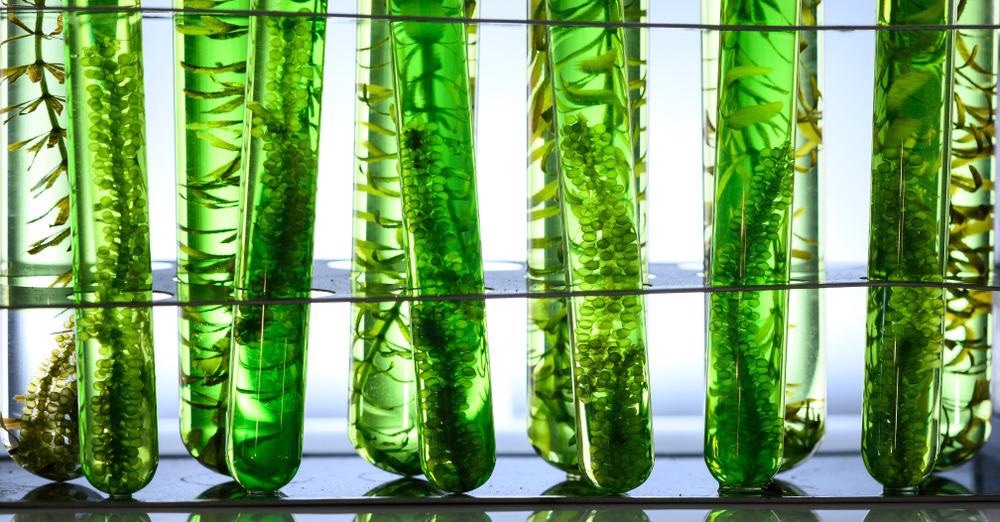
Image Credit: Chokniti Khongchum/Shutterstock.com
Deep in the ocean, diatom algae can survive in harsh conditions thanks to a unique exterior shell. Scientifically known as “diatom frustules”, diatom shells have a chemically unique surface of silica studded with hydroxyl groups. The shells are transparent with multiple layers containing pores that decrease in size to form a funnel shape. This inorganic material is capable of down-converting light; trapping visible light and blocking UV radiation – all of which protect the diatom algae cell and boost photosynthetic processes.
As a central part of its business model, Swedish Algae Factory cultivates diatoms and harvests their unique shells to make distinct light altering, absorbing, and binding materials that compare favorably to similar synthetic materials found in a wide variety of industrial products. Two of the more promising applications of this material are in next-generation solar panels and UV-blocking skin products.
Critical to the function of diatom shells, the sizes of pores within the shells depend on the species. Swedish Algae Factory cultivates diatom algae with the ideal pore structure for specific applications. The company has also developed a business model where diatom algae can address three primary environmental issues: eutrophication, phosphorous waste, and carbon dioxide emissions.
If diatom algae are grown on wastewater, they can purify the water by removing nitrogen and phosphorus. Along the way, a significant amount of carbon dioxide can be absorbed. In addition to producing diatoms shells, the resulting algae biomass could be also used in various applications, including as fertilizer, fish feed, or renewable fuel.
Along with other eukaryotic algae, diatom algae represent approximately 45% of oceanic photosynthesis and around 20% of coal fixation, which is greater than all the rainforests on Earth.
The silica material being extracted by Swedish Algae Factory is currently an untapped resource. This renewable material has remarkable light-altering attributes as well as the capability to soak up or release particles with respect to the adjacent environment.
Designed by nature to capture visible light, block UV light, and manage the handling of chemical substances, diatom frustules have plenty of uses and can replace various harmful or less effective materials. The Swedish Algae Factory intends to use them to enhance the efficiency of both solar panel technology and skincare products. Diatom algae naturally grows near the company’s pilot plant on the west coast of Sweden. According to the company, its production process for its novel additive material, dubbed Algica, is climate-positive, capturing more than eight times the algae’s weight in carbon dioxide and the equivalent of its weight in nitrogen.
Potential Applications for Algica
One of the main targets for Algica is the development of next-generation solar panels; as an ingredient in the encapsulant or as a finish on glass panels.
The Swedish Algae Factory has claimed Algica can improve the efficiency of silicon solar panels by 4%. The material is also long-lasting and could significantly boost the lifetime of next-generation solar panels, as obstructing damaging UV radiation can mitigate the deterioration of solar panels as time passes.
The business said these claims were validated by the state-backed Swedish research institute RISE. Tests with prospective customers have also confirmed the benefits to solar panel technology. The company said using higher concentrations of Algica and considering the effects related to longer lifespan can translate to efficiency gains of 10%.
The Swedish Algae Factory has also developed Algica as a UV-blocking natural additive for sunscreens and other personal care products. The silica from diatom algae has been shown to be a moisturizer, cleanser, and anti-toxin substance. Its multi-purpose nature can offer value in a broad assortment of products where the silica material can take the place of several ingredients in anything from facial masks to serums.
Algica as a dry powder is more suitable for oil-based preparations, while a water-based cream version is best for water-based preparations. The company said Algica is environmentally safe to use as a sunscreen in lakes, streams, oceans, and other natural bodies of water.
Founded on years of academic research on the structure of diatom algae, Swedish Algae Factory was established in 2016. The company has claimed to be the only large-scale commercial producer of diatom shells in the world, with patents pending for its cultivation method and applications.
Resources and Further Reading
Swedish Algae Factory. The Swedish Algae Factory Team. [Online] Available at: https://www.swedishalgaefactory.com/
Swedish Algae Factory. Algica – a multifunctional skincare ingredient. Naturally high-tech. [Online] Available at: https://www.swedishalgaefactory.com/
Swedish Algae Factory. Solar Efficiency Enhancing Nanoporous Material. [Online] Available at: https://www.swedishalgaefactory.com/
Bioenergy International. Swedish Algae Factory raises SEK 53 million for algae production expansion. [Online] Available at: https://bioenergyinternational.com/biochemicals-materials/swedish-algae-factory-raises-sek-53-million-for-algae-derived-products-expansion
Disclaimer: The views expressed here are those of the author expressed in their private capacity and do not necessarily represent the views of AZoM.com Limited T/A AZoNetwork the owner and operator of this website. This disclaimer forms part of the Terms and conditions of use of this website.